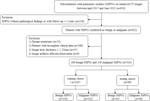European Radiology Experimental ( IF 3.7 ) Pub Date : 2024-01-17 , DOI: 10.1186/s41747-023-00400-6 Jianing Liu 1 , Linlin Qi 1 , Yawen Wang 1 , Fenglan Li 1 , Jiaqi Chen 1 , Shulei Cui 1 , Sainan Cheng 1 , Zhen Zhou 2 , Lin Li 1 , Jianwei Wang 1

|
Background
We aimed to develop a combined model based on radiomics and computed tomography (CT) imaging features for use in differential diagnosis of benign and malignant subcentimeter (≤ 10 mm) solid pulmonary nodules (SSPNs).
Methods
A total of 324 patients with SSPNs were analyzed retrospectively between May 2016 and June 2022. Malignant nodules (n = 158) were confirmed by pathology, and benign nodules (n = 166) were confirmed by follow-up or pathology. SSPNs were divided into training (n = 226) and testing (n = 98) cohorts. A total of 2107 radiomics features were extracted from contrast-enhanced CT. The clinical and CT characteristics retained after univariate and multivariable logistic regression analyses were used to develop the clinical model. The combined model was established by associating radiomics features with CT imaging features using logistic regression. The performance of each model was evaluated using the area under the receiver-operating characteristic curve (AUC).
Results
Six CT imaging features were independent predictors of SSPNs, and four radiomics features were selected after a dimensionality reduction. The combined model constructed by the logistic regression method had the best performance in differentiating malignant from benign SSPNs, with an AUC of 0.942 (95% confidence interval 0.918–0.966) in the training group and an AUC of 0.930 (0.902–0.957) in the testing group. The decision curve analysis showed that the combined model had clinical application value.
Conclusions
The combined model incorporating radiomics and CT imaging features had excellent discriminative ability and can potentially aid radiologists in diagnosing malignant from benign SSPNs.
Relevance statement
The model combined radiomics features and clinical features achieved good efficiency in predicting malignant from benign SSPNs, having the potential to assist in early diagnosis of lung cancer and improving follow-up strategies in clinical work.
Key points
• We developed a pulmonary nodule diagnostic model including radiomics and CT features.
• The model yielded the best performance in differentiating malignant from benign nodules.
• The combined model had clinical application value and excellent discriminative ability.
• The model can assist radiologists in diagnosing malignant from benign pulmonary nodules.
Graphical Abstract
中文翻译:

开发基于放射组学和 CT 特征的组合模型,用于区分良恶性亚厘米实性肺结节
背景
我们的目标是开发一种基于放射组学和计算机断层扫描(CT)成像特征的组合模型,用于良性和恶性亚厘米(≤10毫米)实性肺结节(SSPN)的鉴别诊断。
方法
回顾性分析2016年5月至2022年6月期间324例SSPN患者。其中经病理证实为恶性结节( n = 158),经随访或病理证实为良性结节( n = 166)。 SSPN 分为训练组 ( n = 226) 和测试组 ( n = 98)。从增强 CT 中总共提取了 2107 个放射组学特征。使用单变量和多变量逻辑回归分析后保留的临床和 CT 特征来开发临床模型。使用逻辑回归将放射组学特征与 CT 成像特征相关联,建立组合模型。使用受试者工作特征曲线下面积(AUC)评估每个模型的性能。
结果
六个 CT 成像特征是 SSPN 的独立预测因子,降维后选择了四个放射组学特征。由逻辑回归方法构建的组合模型在区分恶性和良性 SSPN 方面具有最佳性能,训练组的 AUC 为 0.942(95% 置信区间 0.918-0.966),训练组的 AUC 为 0.930(0.902-0.957)。测试组。决策曲线分析表明组合模型具有临床应用价值。
结论
结合放射组学和 CT 成像特征的组合模型具有出色的区分能力,可以帮助放射科医生诊断良性 SSPN 的恶性。
相关性声明
该模型结合放射组学特征和临床特征,在预测良性 SSPN 的恶性方面取得了良好的效率,有可能协助肺癌的早期诊断和改善临床工作中的随访策略。
关键点
• 我们开发了一种肺结节诊断模型,包括放射组学和CT 特征。
• 该模型在区分恶性结节和良性结节方面表现最佳。
• 组合模型具有临床应用价值和良好的判别能力。
• 该模型可以帮助放射科医生诊断肺结节的良恶性。




















































 京公网安备 11010802027423号
京公网安备 11010802027423号